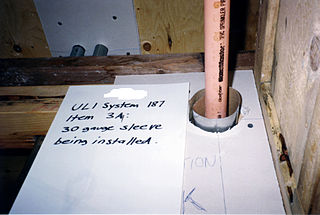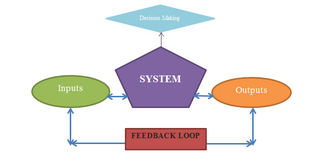Related Research Articles

Chlorine is a chemical element with the symbol Cl and atomic number 17. The second-lightest of the halogens, it appears between fluorine and bromine in the periodic table and its properties are mostly intermediate between them. Chlorine is a yellow-green gas at room temperature. It is an extremely reactive element and a strong oxidising agent: among the elements, it has the highest electron affinity and the third-highest electronegativity on the revised Pauling scale, behind only oxygen and fluorine. On several scales other than the revised Pauling scale, nitrogen's electronegativity is also listed as greater than chlorine's, such as on the Allen, Allred-Rochow, Martynov-Batsanov, Mulliken-Jaffe, Nagle, and Noorizadeh-Shakerzadeh electronegativity scales.

Polyvinyl chloride (alternatively: poly , colloquial: polyvinyl, or simply vinyl; abbreviated: PVC is the world's third-most widely produced synthetic polymer of plastic. About 40 million tons of PVC are produced each year.

Sodium hypochlorite is an inorganic chemical compound with the formula NaOCl, comprising a sodium cation and a hypochlorite anion. It may also be viewed as the sodium salt of hypochlorous acid. The anhydrous compound is unstable and may decompose explosively. It can be crystallized as a pentahydrate NaOCl·5H
2O, a pale greenish-yellow solid which is not explosive and is stable if kept refrigerated.

Dichloromethane is an organochlorine compound with the formula CH2Cl2. This colorless, volatile liquid with a chloroform-like, sweet odour is widely used as a solvent. Although it is not miscible with water, it is polar, and miscible with many organic solvents.

Phthalates, or phthalate esters, are esters of phthalic acid. They are mainly used as plasticizers, i.e., substances added to plastics to increase their flexibility, transparency, durability, and longevity. They are used primarily to soften polyvinyl chloride (PVC). Note that while phthalates are usually plasticizers, not all plasticizers are phthalates. The two terms are specific and unique and cannot be used interchangeably.

Cosmetology is the study and application of beauty treatment. Branches of specialty include hairstyling, skin care, cosmetics, manicures/pedicures, non-permanent hair removal such as waxing and sugaring, and permanent hair removal processes such as electrology and intense pulsed light (IPL).

The Restriction of Hazardous Substances Directive 2002/95/EC, short for Directive on the restriction of the use of certain hazardous substances in electrical and electronic equipment, was adopted in February 2003 by the European Union.
A plasticizer is a substance that is added to a material to make it softer and more flexible, to increase its plasticity, to decrease its viscosity, and/or to decrease friction during its handling in manufacture.

Air fresheners are consumer products that typically emit fragrance and are used in homes or commercial interiors such as restrooms, foyers, hallways, vestibules and other smaller indoor areas, as well as larger areas such as hotel lobbies, auto dealerships, medical facilities, public arenas and other large interior spaces. Car fresheners are used in automobiles. As a source of odors, specific deodorizing blocks are made for toilets and urinals.

Chlorinated polyvinyl chloride (CPVC) is a thermoplastic produced by chlorination of polyvinyl chloride (PVC) resin. CPVC is significantly more flexible than PVC, and can also withstand higher temperatures. Uses include hot and cold water delivery pipes and industrial liquid handling. CPVC, like PVC, is deemed safe for the transport and use of potable water.

Cradle-to-cradle design is a biomimetic approach to the design of products and systems that models human industry on nature's processes, where materials are viewed as nutrients circulating in healthy, safe metabolisms. The term itself is a play on the popular corporate phrase "cradle to grave", implying that the C2C model is sustainable and considerate of life and future generations—from the birth, or "cradle", of one generation to the next generation, versus from birth to death, or "grave", within the same generation.

Regenerative design is a process-oriented whole systems approach to design. The term "regenerative" describes processes that restore, renew or revitalize their own sources of energy and materials. Regenerative design uses whole systems thinking to create resilient and equitable systems that integrate the needs of society with the integrity of nature.

The Consumer Product Safety Improvement Act (CPSIA) of 2008 is a United States law signed on August 14, 2008 by President George W. Bush. The legislative bill was known as HR 4040, sponsored by Congressman Bobby Rush (D-Ill.). On December 19, 2007, the U.S. House approved the bill 407-0. On March 6, 2008, the U.S. Senate approved the bill 79-13. The law—public law 110-314—increases the budget of the Consumer Product Safety Commission (CPSC), imposes new testing and documentation requirements, and sets new acceptable levels of several substances. It imposes new requirements on manufacturers of apparel, shoes, personal care products, accessories and jewelry, home furnishings, bedding, toys, electronics and video games, books, school supplies, educational materials and science kits. The Act also increases fines and specifies jail time for some violations.
The Living Building Challenge is an international sustainable building certification program created in 2006 by the non-profit International Living Future Institute. It is described by the Institute as a philosophy, advocacy tool and certification program that promotes the measurement of sustainability in the built environment. It can be applied to development at all scales, from buildings—both in new constructions and renovations—to infrastructure, landscapes, neighborhoods, both urban and rural communities, and differs from other green certification schemes such as LEED or BREEAM.
The California Green Chemistry Initiative (CGCI) is a six-part initiative to reduce public and environmental exposure to toxins through improved knowledge and regulation of chemicals; two parts became statute in 2008. The other four parts were not passed, but are still on the agenda of the California Department of Toxic Substances Control green ribbon science panel discussions. The two parts of the California Green Chemistry Initiative that were passed are known as AB 1879 : Hazardous Materials and Toxic Substances Evaluation and Regulation and SB 509 : Toxic Information Clearinghouse. Implementation of CGCI has been delayed indefinitely beyond the January 1, 2011.

The Bullitt Center is a commercial office building at the intersection of the Central District neighborhood, and Capitol Hill, Seattle, Washington. It was officially opened on Earth Day, April 22, 2013. The Bullitt Center was designed to be the greenest commercial building in the world, and was certified as a "Living Building" by the International Living Future Institute in April 2015.
Chlorinated polyethylene is an inexpensive variation of polyethylene, where chlorine is substituted for some of the hydrogen atoms. CPE has a chlorine content from 34 to 44%.

The term cosmetic packaging is used for cosmetic containers and secondary packaging of fragrances and cosmetic products. Cosmetic products are substances intended for human cleansing, beautifying and promoting an enhanced appearance without altering the body's structure or functions.
The GreenScreen for Safer Chemicals is a transparent, open standard for assessing chemical hazard that supports alternatives assessment for toxics use reduction through identifying chemicals of concern and safer alternatives. It is used by researchers, product formulators and certifiers in a variety of industries, including building products, textiles, apparel, and consumer products.
An environmentally-friendly red-light flare was a pyrotechnic (firework) flare which used lithium-based formulations that emitted red light. A flare is used for signaling, illumination, or defensive countermeasures in civilian or military applications. It is based on a non-hygroscopic dilithium nitrogen-rich salt that served as an oxidizer and red colorant. The U.S. Army Research Laboratory and the Ludwig Maximilian Institution were credited as the research facilities for developing this product announced in January 2018.
References
- ↑ "Living Building Challenge 3.0; International Living Future Institute" (PDF). living-future.org. Retrieved 15 November 2015.
- ↑ "Red List Exceptions; International Living Future Institute". living-future.org. Retrieved 15 November 2015.
- ↑ "Declare Product Standard; International Living Future Institute". declareproducts.com. Retrieved 15 November 2015.
- ↑ "Declare and the Living Building Challenge; International Living Future Institute". declareproducts.com. Retrieved 15 November 2015.
- ↑ "Perkins + Will Transparency Database; Perkins + Will". perkinswill.com. Retrieved 15 November 2015.